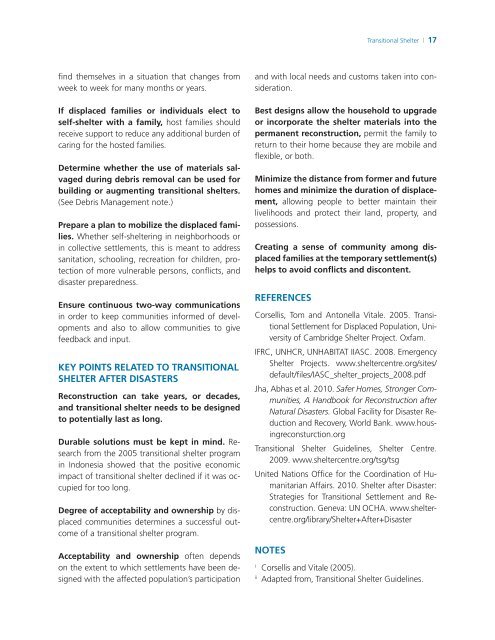Haiti Earthquake Reconstruction Knowledge Notes from ... - GFDRR
Haiti Earthquake Reconstruction Knowledge Notes from ... - GFDRR
Haiti Earthquake Reconstruction Knowledge Notes from ... - GFDRR
Create successful ePaper yourself
Turn your PDF publications into a flip-book with our unique Google optimized e-Paper software.
Transitional Shelter | 17<br />
find themselves in a situation that changes <strong>from</strong><br />
week to week for many months or years.<br />
If displaced families or individuals elect to<br />
self-shelter with a family, host families should<br />
receive support to reduce any additional burden of<br />
caring for the hosted families.<br />
Determine whether the use of materials salvaged<br />
during debris removal can be used for<br />
building or augmenting transitional shelters.<br />
(See Debris Management note.)<br />
Prepare a plan to mobilize the displaced families.<br />
Whether self-sheltering in neighborhoods or<br />
in collective settlements, this is meant to address<br />
sanitation, schooling, recreation for children, protection<br />
of more vulnerable persons, conflicts, and<br />
disaster preparedness.<br />
Ensure continuous two-way communications<br />
in order to keep communities informed of developments<br />
and also to allow communities to give<br />
feedback and input.<br />
KEY POINTS RELATED TO TRANSITIONAL<br />
SHELTER AFTER DISASTERS<br />
<strong>Reconstruction</strong> can take years, or decades,<br />
and transitional shelter needs to be designed<br />
to potentially last as long.<br />
Durable solutions must be kept in mind. Research<br />
<strong>from</strong> the 2005 transitional shelter program<br />
in Indonesia showed that the positive economic<br />
impact of transitional shelter declined if it was occupied<br />
for too long.<br />
Degree of acceptability and ownership by displaced<br />
communities determines a successful outcome<br />
of a transitional shelter program.<br />
Acceptability and ownership often depends<br />
on the extent to which settlements have been designed<br />
with the affected population’s participation<br />
and with local needs and customs taken into consideration.<br />
Best designs allow the household to upgrade<br />
or incorporate the shelter materials into the<br />
permanent reconstruction, permit the family to<br />
return to their home because they are mobile and<br />
flexible, or both.<br />
Minimize the distance <strong>from</strong> former and future<br />
homes and minimize the duration of displacement,<br />
allowing people to better maintain their<br />
livelihoods and protect their land, property, and<br />
possessions.<br />
Creating a sense of community among displaced<br />
families at the temporary settlement(s)<br />
helps to avoid conflicts and discontent.<br />
REFERENCES<br />
Corsellis, Tom and Antonella Vitale. 2005. Transitional<br />
Settlement for Displaced Population, University<br />
of Cambridge Shelter Project. Oxfam.<br />
IFRC, UNHCR, UNHABITAT IIASC. 2008. Emergency<br />
Shelter Projects. www.sheltercentre.org/sites/<br />
default/files/IASC_shelter_projects_2008.pdf<br />
Jha, Abhas et al. 2010. Safer Homes, Stronger Communities,<br />
A Handbook for <strong>Reconstruction</strong> after<br />
Natural Disasters. Global Facility for Disaster Reduction<br />
and Recovery, World Bank. www.housingreconsturction.org<br />
Transitional Shelter Guidelines, Shelter Centre.<br />
2009. www.sheltercentre.org/tsg/tsg<br />
United Nations Office for the Coordination of Humanitarian<br />
Affairs. 2010. Shelter after Disaster:<br />
Strategies for Transitional Settlement and <strong>Reconstruction</strong>.<br />
Geneva: UN OCHA. www.sheltercentre.org/library/Shelter+After+Disaster<br />
notes<br />
i<br />
Corsellis and Vitale (2005).<br />
ii<br />
Adapted <strong>from</strong>, Transitional Shelter Guidelines.

















